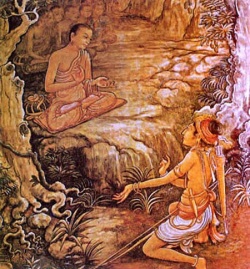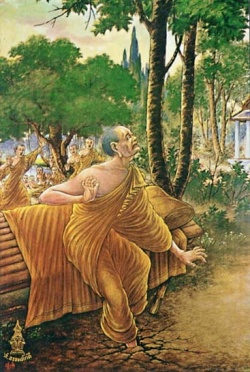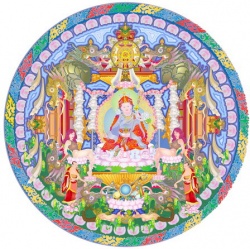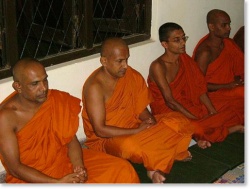Sarvastivada School of Realism
Jump to navigation
Jump to search
Sarvastivada School of Realism
by
Vira Avalokita, Sthera
I. Sarvastivada Teachings:
- A. Basic Claim: The ultimate constituents that make up interdependent arising are real; otherwise nothing could possibly exist.
- B. Ultimate constituents of reality = Dharmas.
- 1. Dharmas are held to be “self-existing.”
The existence of dharmas is not dependent on anything else. - 2. Dharmas have their own nature
– each has a unique and defining characteristic.
- 1. Dharmas are held to be “self-existing.”
- C. Analysis is analogous to contemporary scientific theory:
ordinary perception versus scientific analysis.
Foundations of Theories:
Sarvastivadin theory is based on Scientific Inquire, which contains classification of objects (dharmas) based on experience.
- A. Sarvastivadain Theoretical Reasoning
- 1. Basic Objective:
To show, that the Dharmas are the ultimately real and self-existing. All other reality is constructed from them. - 2. Establishing Reality:
The reality of a person comes from the reality of the person’s constitutive processes. But persons are real only if the constituents are real. - 3. Identity:
The ultimate constituents determine identity. Without identity there could be no Buddha, no-one on the Eightfold Path, etc. - 4. Continuity:
The dharmas must have sufficient duration to support successive moments of existence. Otherwise, the person who experience dukkha is not the same person who later practices the path. Then there would be no point in practice. - 5. Knowablity:
unless the dharmas are fundamentally real, knowledge is impossible. We believed that the momentary duration of the existence of dharmas makes them knowable as unique objects. - 6. Types of Ultimate Constituents:
In addition to the traditional Theory lists, Sarvastivadins added other dharmas to explain know ability, continuity, and identity.
- 1. Basic Objective:
Arguments against Substance:
Buddhists generally argue against existence as a substance common to Hindu thought (especially Nyaya and Vaisheshika). Basic Argument: Either the substance view of existence is true or interdependent arising is true. The substance view is untenable. Therefore, interdependent arising is true.
- A. The Concept of Substance
- 1. Permanence – essences are unchanging.
- 2. Universality – essence is the same everywhere at all times.
- 3. Identity – substances are identical to themselves despite change.
- 4. Unity – the components or characteristics of a thing are unified by inherence in a substance.
- B. Arguments against Permanence
- 1. The Upanishad’s assume that if something is ultimately real it must be changeless. But whatever is unchanging cannot produce effects, since effects involve change. Causes can be known only by effects. If reality is changeless, it is therefore unknowable (reductio).
- 2. Knowledge argument: Coming to know something involves a change in the knower. If the self cannot change, it cannot know.
- 3. Causality argument: Change is fact of our experience. But how can something unchanging bring about change. Causation is either temporally extended or instantaneous. It can’t be instantaneous; there could be further change.
- 4. If the real causes instantaneously, either it continues to exist as a cause or it doesn’t. If it does continue to exist as a cause, it would give rise to the very same effects (unless it changed, which it can’t). If ceases to exist as cause, it has changed.
- 5. Temporally extended causality: If R produces x, y, and z, then either [1] y or z could have been produced while x was produced or [2] R could not produce y and z while x was produced. [1] is absurd, because this amounts to instantaneous causation. [2] is absurd because if at any time R cannot produce y or z, there is no time when R can produce them – unless there are other causal conditions, which would amount to a change in R.
- C. Arguments against Identity:
Substance view of identity entails that a thing remains identical to itself through time unless it is destroyed or altered by outside forces. The our argument is that unless the nature of an object were change and cessation, no outside force could alter it or bring about its demise. - Arguments against Unity:
The substance assumption is that while an object is composed of parts, we can know it as a whole. We argue that perception only gives us parts. There is no direct perceptual evidence of unity. Instead, unity is a construction of mind onto our experience that has pragmatic value. Reality is no more than successive momentary elements – like the pictures that flow together to form a film. - E. Arguments against Universality:
Universal essences are what unite particulars into a single category.
We argue:- 1. Perception gives us only particular things.
- 2. By what mechanism do universals reside in particular things?
- 3. Why are universals unaffected by what happens to particulars?
- 4. How can universals be known? One answer appears to be a kind of “double perception.” One perceives not only the particular object, but also the universal, which is then applied to the object. But how can we perceive timeless, space less universals? We contend that universals are practical mental construction (abstractions) that we create for various useful purposes.
Our Views:
- A. Are Constant with the following:
- B. The Buddha
- 1. Was historical
- 2. Not beyond infallibility
- 3. Nothing extraordinary about him
- 4. Not everything he said was a Law or perfect
- C. The Sangha
- 1. Is open to all
- 2. Democratic
- 3. Can change with the times
- 4. All Discipline is changeable
Source
Submitted by Vira Avalokita




